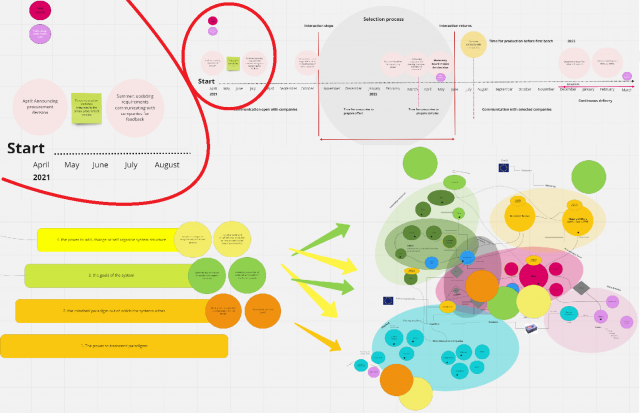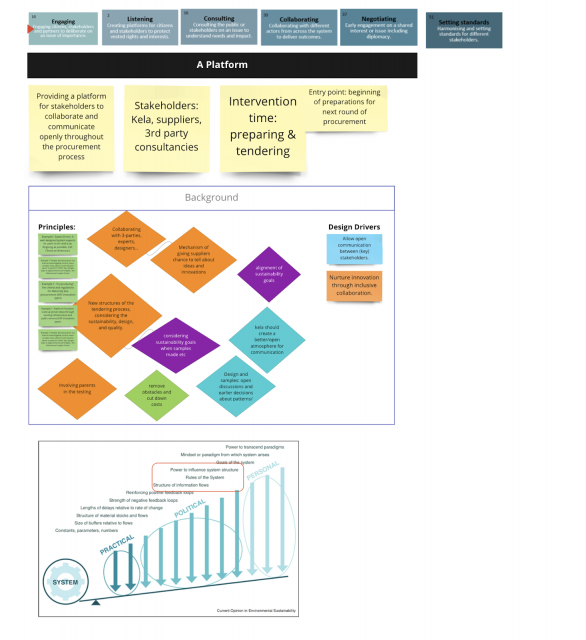
These blog posts report on work-in-progress within the DfG course! The posts are written by groups dealing with the Ministry of Economic Affairs and Employment’s brief on ‘Reducing the carbon footprint of procurement services’.
—
Group 2B: Andre Helgestad, Nicole Grekov and Sara D’Angelo from the Creative Sustainability program and Shreya Shrivastava from the Collaborative and Industrial Design program.
From understanding to actions: identifying leverage points for potential solutions
The past few weeks we have been spending time in the transition phase between the problem framing and solution definition phases, so in other words between understanding the problem and ideating concrete solutions. The in-between time has felt confusing, somewhat unsettling, but exciting.
Slowly we have started narrowing down which findings are the most interesting to us, appear most fruitful in terms of potential solutions, and where we feel we could affect the most meaningful change. We have tried to hold ourselves in the space between insights and tangible solutions and make sure there is a clear connection between what challenges we have observed in the interviews, which drivers and motivations direct us to solve those challenges, and finally what those solutions look like in practice. The in-between stage requires patience and the ability to withstand incompleteness. But it allows time for ideas to brew before they bloom.

Identifying effective points for change
We have identified several leverage points which are places in a system where interventions and new solutions can lead to big or small changes in behavior (Meadows, 2008). Still, we are yet to determine which one(s) we want to focus on or if there is a way to address them all at once as many of them are clearly connected. We have tried putting the leverage points on the systems map and the procurement timeline, that we created based on the information we gathered in the last phase of the project, to understand them better.
Working with the systems map allows us to see which actors would be involved in enacting change while looking at the procurement timeline informs us where in the process change would be possible and effective. Working with both means we can identify which actors can impact the process and when, as well as who else is involved. We also get a decent idea of how much time there is realistically for potential leveraging actions like workshops, collecting feedback, and communication.

Beginning an ongoing conversation
Planning our upcoming workshop with the stakeholders has largely been about figuring out what we still want to know more about to be able to propose the best solutions, but also about turning the workshop into a tool itself that can help along on the journey towards a more sustainable procurement process. The best-case scenario would be for the workshop to serve as an example for something the stakeholders could carry out themselves annually.
We believe continuous improvement is important and for improvement, continuous feedback is key. For example, as we have seen throughout this process the definition of sustainability varies from person to person and organization to organization, and we believe even further it is going to keep changing over time. Therefore, redefining sustainability would be important to revisit frequently, even if there was a way to perfectly define it at the end of this project. So, in the workshop, we would like to both start creating a consensus for what sustainability means for the whole system right now, but also introduce tools for all the participants to keep having this conversation on what sustainability is and how it is performed in the maternity box procurement.
Tendering as a dialogue
We continue to be intrigued by the idea of rethinking the tenders and hope to probe this more in the workshop. The tendering process is where the different stakeholders have the most contact with each other and therefore a significant tool for communication. We think this communication could benefit from more dialogue so ultimately that is one of our main goals moving towards the workshop. However, not being experts in creating or carrying out a tendering process, we need help from the stakeholders to make it better, not in just theory but also in practice.
Next steps
Tipping our toes into the solution definition phase has been very exciting, as experiencing those “Aha!” moments, when pieces seem to fall into place, is very rewarding. We feel we have a good grasp of the topic now, with its challenges and opportunities, and are ready to put all this knowledge to use. It will be very interesting for us to see the workshop play out, and we are certainly looking forward to talking to everyone we have interviewed before as well as meeting new stakeholders who are all very important to the maternity box procurement process as a whole. Hope to see you there!
Reference
Meadows, D.H. (2008.) Leverage Points — Places to Intervene in a System. In D. Wright (Ed.). Thinking in Systems: a Primer (pp. 145-165). Chelsea, Vermont: Chelsea Green Publishing.
—
Group 2c: Joosep Laht and Loren Córdoba from Collaborative and Industrial Design program, and Tessa Kauppinen and Junrui Li from Creative Sustainability program.
Fresh eyes on the project: framing our intervention
After finishing the research phase and having an Easter break we came back with fresh eyes and new ideas to focus our efforts on framing solutions for sustainable public procurement. We used our findings to define our design drivers to help us to tackle the problems identified in the previous phase.
In this phase, we concreted on finding the points of power on the system and how to make the proper intervention to change the public procurement. To achieve and push the change in the right direction we started by mapping the leverage points and identifying at which levels the intervention can make an impact on the system. In order to understand better how interventions can change the system, we look for examples of interventions called nudges, explained by Thaler (2013) as the creation of conditions or environments in which human behavior changes.

Framing the solution:
Having this in mind, we address our attention on the intervention process/phase, using the design drivers as frames to generate ideas. As well as, the behavioral insights to define design directions that help to tackle the problems faced by the stakeholders. This leads us to identify the leverage points of the system, where we think intervention will have a significant impact to encourage desirable behaviours like collaboration and communication.
Our next step is to validate our identified leverage points and/or prioritise the level of intervention we want to focus on, due to “nudges are often cheap to implement, as they frequently involve changing the way choices are presented”. (Behavioural Insights Team (2020). This will help us to narrow down the scope and provide a feasible solution for sustainable public procurement.

References:
Policy Lab. (2020). Introducing a “Government as a System” toolkit. https://openpolicy.blog.gov.uk/2020/03/06/introducing-a-government-as-a-system-toolkit/
Thaler, R. H., Sunstein, C. R., Balz, J. P. (2013). Choice Architecture. In Shafir, E. (Ed.), The behavioral foundations of public policy (pp. 428–439). Princeton University Press.
United Nations Environment Programme, GRIDArendal and Behavioural Insights Team (2020). The Little Book of Green Nudges: 40 Nudges to Spark Sustainable Behaviour on Campus. Nairobi and Arendal: UNEP and GRID-Arendal.
—
Group 2A: Xinghua Meng, Kalle Kaisko, Michael Buchta from the Creative Sustainability program and Amandine Fong from the Collaborative and Industrial Design program.
A Closer Look at the Procurement Process
The past weeks 6 to 8 have been a stage of going back and forward. Since getting Kela’s feedback on our research insights, we have focused on narrowing down the themes by summarising design drivers, locating possible leverage points, and framing the interventions. Gradually, our ideas are becoming clearer and are slowly being crystallised into proposals.
Design Drivers: Taking the First Step towards the Solution
Entering the phase of turning problems into solutions, the process begins to move more slowly and cautiously. The first step we made was to list design drivers based on our identified problem area. The purpose of the design driver is to define the boundaries of solution space and find the specific level that we want to put the leverage point on.
According to findings in the research phase, we landed our core design drivers on the three themes – procurement criteria, Kela-producer communication, and procurement process & practicalities. They are strongly linked to each other and were brought several times during problem defining. Therefore, we eventually described our design drivers as follows:
- Create comprehensible legal & sustainability frameworks
- Enable active dialogue between Kela and the producers
- Simplify the procurement process
- Re-evaluate the use of sustainability criteria & design for busy procurers
- Create a political will & create within the existing limitations
These three principles will be the very first step to form the structure of our solution and keep guiding us during the rest of the design process.
Out of the Mist Using Multiple Tools
With all the information and themes we concluded, it is exciting but also challenging to target the right leverage point. In order to achieve it, we used multiple tools to help us map out our solution.
Firstly, we have reorganised our design drivers, determining that our intervention area will be around the three core principles. Secondly, we looked back at the system map, trying to point out where we wanted to make changes and bring new connections in the system perspective. You can see how the design drivers engage in the map as below:

We also defined our intervention in the policy framing phase, referring to the model of four areas of design in policy (Junginger, 2015), and target the intervention types (Policy Lab, 2020). In addition, we think about how our design drivers work in a timeline perspective and how some inspiring examples can be incorporated, e.g. Dutch SPP criteria (PIANOo, n.d.).
Our ideas emerge step by step in these models: we intend to start by focusing on improving the environment for dialogue throughout the simplified process, as well as improving the integration of the various stakeholder roles and providing advice on sustainable criteria.
Taking a step back, it is a rewarding process to use multiple tools and models to shape our ideas. On the one hand, it provides different dimensions for us to look at the problem and information that we had and to reorganise our thoughts according to the different layers. On the other hand, it helps the whole group have a clear picture in sync. Until now, it is still an incomplete picture, but we indeed are on a more concrete stage than the beginning of week 6.
A More Grounded Future, More Voices…
With more precise interventions, we are marching towards the stage of proposals. In the following weeks, we will focus on translating proposals into practice and keep learning from good procurement examples. Meanwhile, a co-creation workshop prepared among the supergroup for the further verification and ideation of design interventions will be held on May 11th. We are more confident and experienced at organising it. We look forward to hearing voices and opinions from different stakeholders.
Resources:
Junginger, S. (2015). Design and Innovation in the Public Sector: Matters of Design in Policy-Making and Policy Implementation. 11.
PIANOo. (n.d.). Maatschappelijk Verantwoord Inkopen | PIANOo—Expertisecentrum Aanbesteden. Retrieved April 30, 2021, from https://www.pianoo.nl/nl/themas/maatschappelijk-verantwoord-inkopen
Policy Lab. (2020). Introducing a “Government as a System” toolkit. Www.Gov.Uk. https://openpolicy.blog.gov.uk/2020/03/06/introducing-a-government-as-a-system-toolkit/
—

